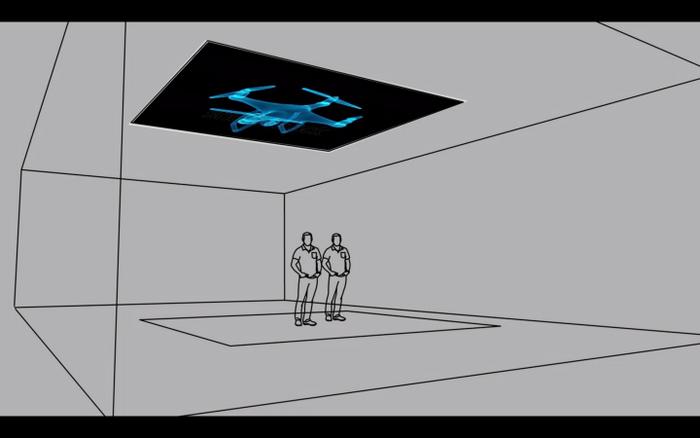
Initial Plan
“Radius 1 & 2” are the brainchild of artist/filmmaker Ibrahim Quraishi with cyber philosopher/technology researcher Stanislaw Liguzinski. The footage was taken on a home-made drone while traveling by car from the United Arab Emirates, Bahrain, Oman in an attempt to enter the war zone of Yemen. On the way through this tranquil landscape of the southern Arabian Gulf, we suddenly came across an ominous area of a massive military-industrial complex. Forbidden to enter or even cross the blocked zone, we had no choice but to use cyber technology to understand the dimensions of war and peace in the Arab World.
Design Plans
Radius 1 & Radius 2 – videos shot with a home-made drone investigate this scenario. They start with generic, comforting aerial shots of the desert and ocean and are displayed on the screen underneath the spectator’s feet. It’s meant to startle us but also reassures our sense of bliss and comfort trained by the drone footage proliferated in cinema and on YouTube – one that is removed enough from our daily perspective to create a limited sense of awe but stays within the standard frame of reference.
Project Concepts
However, our comforting float is suddenly being interrupted by another image from the same drone – glitched and seemingly frozen, suggesting the elements of thermovision.
While we try to read into the situation, recognizing buildings, cars, and other familiar objects, the point of view starts shifting in an irregular, clunky, and erratic way. Its pace is too slow to satisfy our craving for information, but the unexpected robotic movements that don’t seem to be following any pattern, create a sense of anxiety and alien presence that disturbs the comfort of our “cockpit” or in other words – POV. Suddenly the image goes pitch-black and another screen on the ceiling turns on, revealing the shot of a drone (3rd person perspective) – that our gaze no longer inhabits (and we don’t know what malfunction it is suffering from) hovering above the camera – subjugating us to its own gaze. Space “inside” the drone that we formerly inhabited becomes the space of emancipation for the technology, a space of potentialities that were previously limited by the string of actions programmed by our point of view and we’re left in our own, vulnerable physical space as potential targets.
In Deleuzian terms - the unexpected pause unravels the whole universe of virtual possibilities that may cause the drone to follow the path of "being towards" something else than the extension of our gaze. The video ends right there, and since we put so little thought into understanding what that technologies might be gazing upon, and what it sees when it stares at us (and we didn't exactly teach it the best patterns), our horizon of fantasies is usually limited to Skynet-like (Terminator) "Rise of the machines" scenarios, and we want that dreadful question to linger over the spectator while the piece loops.

About Ibrahim Quraishi
Quraishi is a visual artist whose work includes different mediums; photography, photo painting, video, film, and performance installation. Defined by a nomadic existence and dividing his time in multiple cities between Europe & the Middle East, Quraishi consciously examines the dynamics of migration, dispossession, and cohabitation within the highly rigid socio-political spheres of imagined communities inside the contours of the context of the visual arts, while freely playing with the tensions between the complexity of the real and our longing for simplicity.
Quraishi’s primary interest is in the exploration and an understanding of visual performativity and its relationship to the broader cultural perspectives. Embedding his work in the chosen sites and the potential of intersubjective approaches are at the core of his process. Quraishi’s research is rooted in an experiential search of otherings concerning shifts between accepted citizens and non-citizens in our surveillance driven culture.